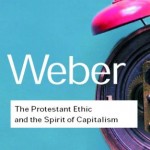That’s the title of a June 2016 Journal of Economic Literature piece, available at a website near you. Typically, this wouldn’t warrant a response from the Lawrence Economics Blog, but typically you don’t see accolades like this directed towards one of our own:
One of the classic papers written on the economics of religion, Azzi and Ehrenberg (1975), summarized the literature on what the empirical correlates of religiosity had discovered about the United States until then.
Wow, classic papers! If you see Professor Azzi, be sure to ask him about the genesis of that paper.
- 2016. “The New Economics of Religion.” Journal of Economic Literature, 54(2): 395-441.
- Corry Azzi and Ronald Ehrenberg. 1975. “Household Allocation of Time and Church Attendance.” Journal of Political Economy 83 (1): 27–56.



 Many theories, most famously Max Weber’s essay on the ‘Protestant ethic,’ have hypothesized that Protestantism should have favored economic development. With their considerable religious heterogeneity and stability of denominational affiliations until the 19th century, the German Lands of the Holy Roman Empire present an ideal testing ground for this hypothesis. Using population figures in a dataset comprising 276 cities in the years 1300-1900, I find no effects of Protestantism on economic growth. The finding is robust to the inclusion of a variety of controls, and does not appear to depend on data selection or small sample size. In addition, Protestantism has no effect when interacted with other likely determinants of economic development. I also analyze the endogeneity of religious choice; instrumental variables estimates of the effects of Protestantism are similar to the OLS results.
Many theories, most famously Max Weber’s essay on the ‘Protestant ethic,’ have hypothesized that Protestantism should have favored economic development. With their considerable religious heterogeneity and stability of denominational affiliations until the 19th century, the German Lands of the Holy Roman Empire present an ideal testing ground for this hypothesis. Using population figures in a dataset comprising 276 cities in the years 1300-1900, I find no effects of Protestantism on economic growth. The finding is robust to the inclusion of a variety of controls, and does not appear to depend on data selection or small sample size. In addition, Protestantism has no effect when interacted with other likely determinants of economic development. I also analyze the endogeneity of religious choice; instrumental variables estimates of the effects of Protestantism are similar to the OLS results.
 So, did Major League Baseball’s steroid craze lead to the decimation of the baseball record book? The argument is straight forward enough, with the help of performance-enhancing drugs, hitters got bigger and stronger and started knocking the tater out of the park with alarming frequency. The extra-ordinary seasons from the likes of Mark McGwire, Sammy Sosa, and Barry Bonds are the proof in the steroid pudding.
So, did Major League Baseball’s steroid craze lead to the decimation of the baseball record book? The argument is straight forward enough, with the help of performance-enhancing drugs, hitters got bigger and stronger and started knocking the tater out of the park with alarming frequency. The extra-ordinary seasons from the likes of Mark McGwire, Sammy Sosa, and Barry Bonds are the proof in the steroid pudding. Would a tax on the sugary, em, I mean the corn syrupy sweet taste of soft drinks reduce consumption? And would that in turn cause young people to drink less and possibly curb the tide of childhood obesity? An
Would a tax on the sugary, em, I mean the corn syrupy sweet taste of soft drinks reduce consumption? And would that in turn cause young people to drink less and possibly curb the tide of childhood obesity? An